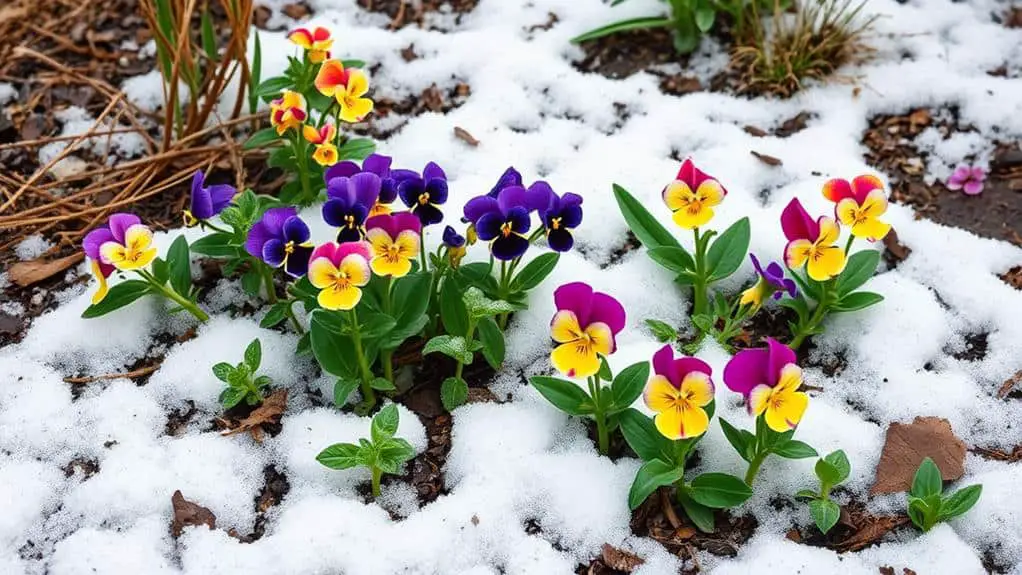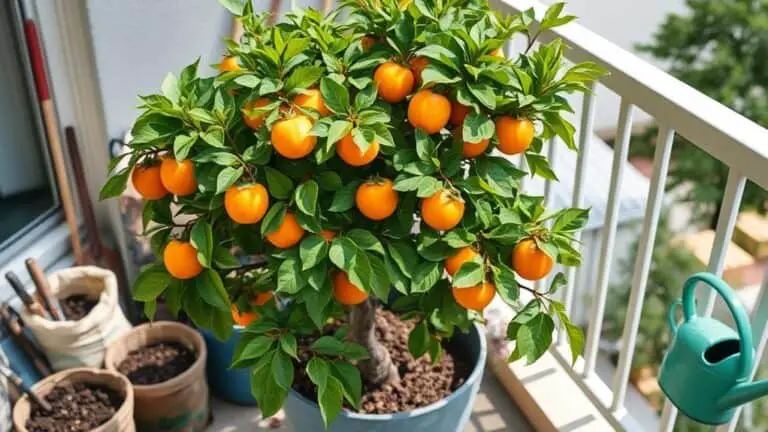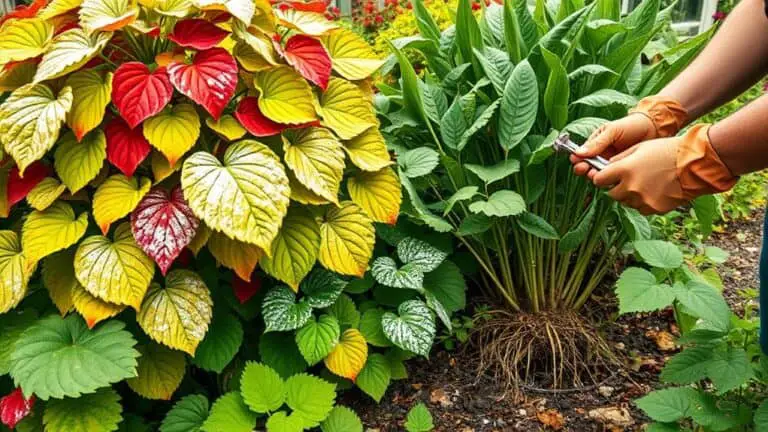Are Pansies Perennials That Will Come Back After Winter
When considering whether pansies are perennials that will return after winter, it's essential to understand their classification and climatic needs. While many pansy varieties are biennials or short-lived perennials, their survival heavily depends on specific factors like the hardiness of the variety and the severity of the winter. For instance, certain hardy varieties can indeed thrive in USDA zones 7 to 10, but what really makes a difference in their return? Let's explore the nuances of winter preparation and the role it plays in ensuring these vibrant blooms grace your garden year after year.
Pansies: Annuals or Perennials?

When figuring out whether pansies are annuals or perennials, it's crucial to take into account their response to different climates. Pansies can be short-lived perennials or biennials, but many gardeners treat them as annuals because they don't tolerate extreme temperatures well.
In USDA zones 7 to 10, pansies might survive winter and return in spring. However, this depends on winter conditions and the local climate.
In colder areas, most commercially available pansy hybrids lack the cold hardiness necessary for perennial survival. To improve their chances, choose hardy varieties like Maxim and Universal. These types are better at handling temperature changes.
Sometimes, pansies might reseed naturally, leading to new growth, even if the original plants don't make it through the winter.
Pansy Lifespan Overview
Understanding the lifespan of pansies is essential for any gardener aiming to maximize their garden's beauty. Pansy lifespan varies based on several factors, but here's a quick overview to help you understand better:
- Biennial Nature: Pansies are typically classified as biennials, blooming in their second year and often not surviving beyond that.
- Hybrid Characteristics: Most commercially available pansies are hybrids, which lack cold hardiness and longevity, resulting in a shorter lifespan.
- Temperate Climates: In temperate climates, pansies can survive for a couple of years and may reseed naturally, leading to new growth.
- General Lifespan: The average lifespan of pansies is about two years, influenced by winter conditions and care.
Climate Impact on Pansies
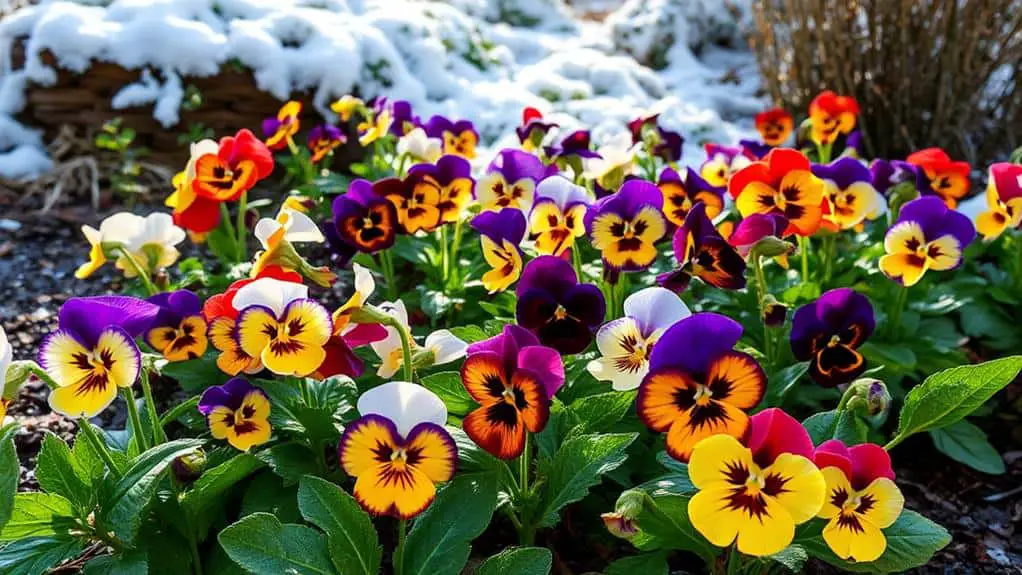
Climate has a huge influence on whether pansies will thrive or merely survive through the winter.
In mild climates, like USDA zones 7 to 10, pansy plants often make it through the colder months and bloom again in spring. However, in colder zones, such as zone 4, they struggle with harsh conditions and may not survive.
Locations with moderate temperatures, like the Pacific Northwest, might see pansies reseed and return annually. Proper winter preparation, such as mulching and cutting back plants, can improve their chances.
Keep in mind, gardener experiences vary. Some pansies bloom beautifully in spring, while others don't make it. Knowing your local climate and preparing accordingly is key to helping your pansy plants thrive.
Hardy Pansy Varieties
When it comes to hardy pansy varieties, Maxim, Universal, and Rococo are some of the best options due to their strong resistance to extreme temperatures.
These varieties can withstand heat and cold, making them reliable choices for surviving winter, especially in USDA zones 7 to 10.
Don't forget about Yesterday, Today and Tomorrow, Springtime, Majestic Giant, and Lyric, which are also known for their resilience.
Temperature Tolerance Range
Selecting the right pansy variety can make all the difference in cold weather. Hardy pansy varieties are specially bred to withstand temperature fluctuations better than standard hybrids.
To help your pansies survive the winter, consider these tips:
- Choose hardy varieties: Look for types like Maxim, Universal, and Rococo which can tolerate temperatures down to 5°F.
- Mulch well: Adding a layer of mulch can protect your pansies by insulating the soil.
- Plant in the right zone: These hardy pansies thrive best in USDA zones 7 to 10.
- Monitor conditions: Hardy pansies can endure cold but need well-drained soil to avoid root rot.
Notable Hardy Varieties
Among the many pansy varieties available, some stand out for their exceptional hardiness and ability to endure winter's chill.
Hardy pansy varieties like Maxim, Universal, and Rococo are particularly remarkable. These types are known for their increased heat and cold tolerance compared to standard pansies.
Other resilient options include Yesterday, Today and Tomorrow, Springtime, Majestic Giant, and Lyric. These pansies are bred to withstand winter conditions, making them ideal for gardens in colder climates.
By choosing hardy pansy varieties, you're enhancing the chances of your flowers returning in spring. Although their exact temperature tolerances aren't specified, they're generally more robust than typical commercial hybrids.
Seasonal Maintenance Tips
To guarantee the hardy pansy varieties like Maxim, Universal, and Rococo thrive through the winter, it's important to focus on seasonal maintenance.
By following a few simple tips, you'll help your pansy flowers endure the cold months and return vibrant in spring.
- Deadhead Regularly: Removing spent blooms encourages new growth and prevents disease.
- Mulch Generously: Apply a thick layer of mulch to protect roots from freeze-thaw cycles.
- Monitor Soil Moisture: Keep the soil consistently moist but not waterlogged, especially before the ground freezes.
- Fertilize Wisely: Use a balanced fertilizer during the growing season to strengthen plants before winter.
With these steps, your hardy pansies should flourish and come back year after year.
Winter Preparation Tips
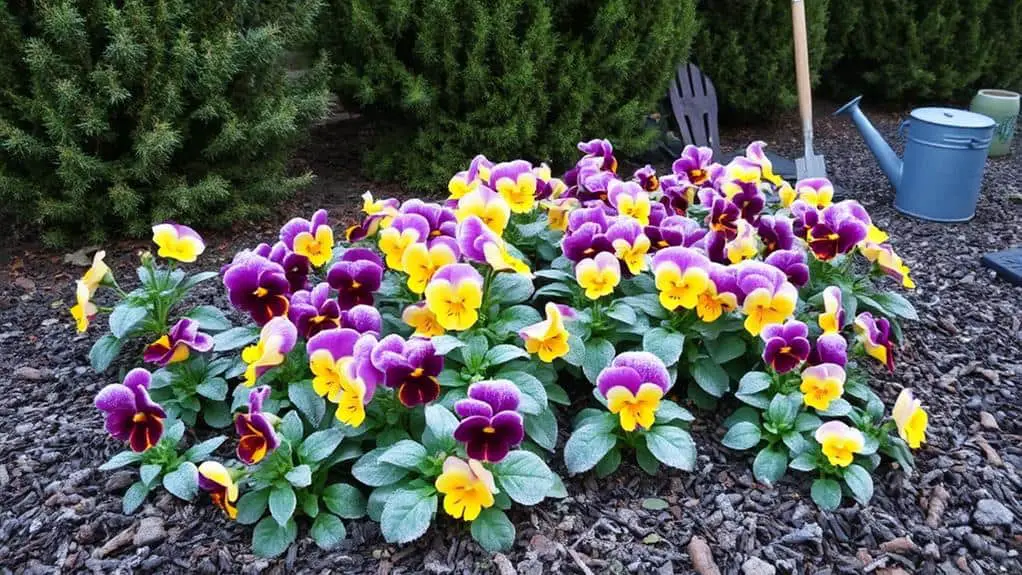
As the temperatures start to drop, it's crucial to prepare your pansies for the winter months to guarantee they thrive when spring arrives.
First, cut back your pansies to about 3-4 inches in late fall. This promotes healthier regrowth.
Next, apply a thick layer of mulch, around 4 inches of shredded leaves, after the ground freezes. This protects the roots from damaging freeze-thaw cycles.
If you're in a milder climate like Zone 6, these winter preparation tips can increase your pansies' chances of survival.
Don't forget to monitor snow cover, as it can insulate the plants and prevent frost damage.
When spring comes, check their health and remove any dead foliage to encourage new growth.
Indoor Storage Methods
When it's late fall, I dig up my pansies and store them in open bags in a cool, dark basement to keep them safe through winter.
It's really important to check on them now and then, as indoor storage can stress the plants.
When spring arrives and the ground has thawed, I make sure to get them back outside where they can thrive.
Digging Up Plants
Often, preserving pansies over the winter involves digging them up in late fall and storing them indoors to protect them from the harsh cold.
When I dig up my pansies, I always check them for signs of health to make certain they'll survive the winter.
Here are some steps I follow to guarantee my pansies stay healthy indoors:
- Place in open bags: I put the pansies in open bags and store them in a cool basement.
- Monitor regularly: I check the plants regularly for stress.
- Avoid prolonged storage: I don't keep them indoors too long to prevent health decline.
- Plan for replanting: When the ground thaws in spring, I replant the pansies, often adding pansy seeds for a fuller garden.
Temporary Storage Solutions
Storing pansies indoors during the winter is a practical way to guarantee their survival until spring. You can dig them up before the first frost and place them in open bags in a cool basement. This temporary storage solution helps reduce stress and prevents moisture accumulation. Remember, timing is essential—wait until the ground thaws in spring to replant them.
Here's a quick guide to winter care:
| Task | Timeframe | Purpose |
|---|---|---|
| Digging up pansies | Before first frost | Prevents frost damage |
| Indoor storage | Winter months | Keeps plants alive indoors |
| Regular checks | Bi-weekly | Look for growth or decay |
| Replanting outdoors | Spring thaw | Avoids plant shock |
| Avoid prolonged storage | Winter | Reduces plant stress |
These steps will help your pansies thrive come spring!
Viability Check Tips
Maintaining the viability of your stored pansies during winter involves a few simple but vital steps. Here's a handy list to help you:
1. Inspect the Plants: Before replanting, check the roots and foliage for any signs of rot or disease.
Healthy pansies are essential for a successful spring bloom.
2. Use Open Bags: Store your pansies in open bags to allow air circulation.
This reduces the risk of fungal growth and keeps the plants healthy.
3. Maintain a Cool, Dark Environment: Keep your pansies in a cool, dark place like a basement.
This minimizes stress and helps preserve their health.
4. Check Soil Moisture: Periodically check the soil moisture.
Avoid letting it get too dry to prevent stress and guarantee your pansies remain viable.
Seed Collection Techniques
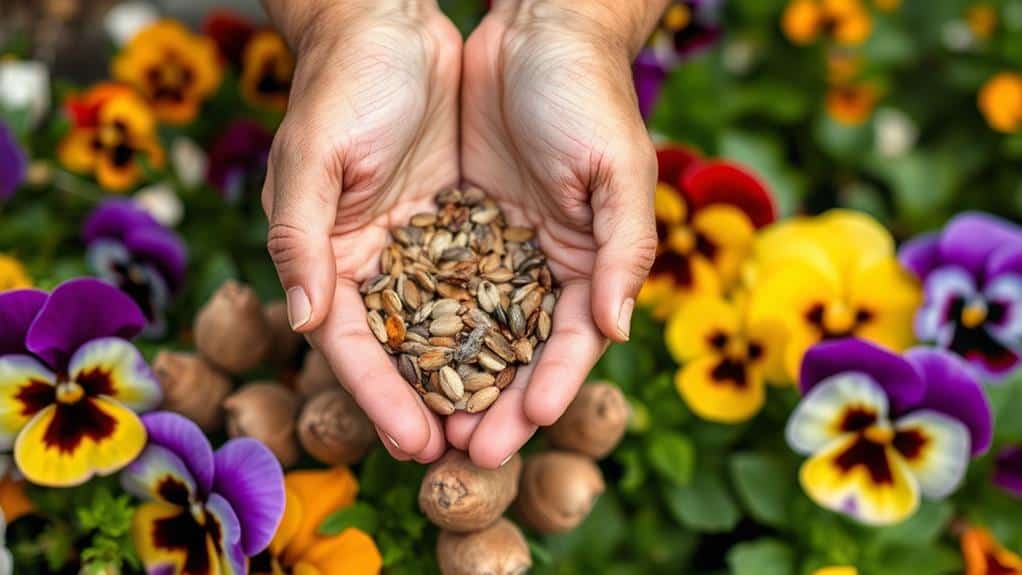
Collecting pansy seeds is a straightforward process that starts with identifying the dry, brown seed pods that form after the flowers have bloomed.
Once the pods are fully dry, gently twist or cut them open to release the small, nut-like seeds inside.
Make sure to store the seeds in a cool, dry place to maintain their viability.
Label the seed packets with the date and variety to track your planting history.
Remember, hybrid pansies may not produce true-to-type offspring, so expect some variability in flower types and colors.
These seed collection techniques will help you prepare for outdoor sowing as early as March or indoor planting in February under grow lights.
Planting and Care Tips
Let's talk about the best times to plant pansies and how to keep them thriving through the winter.
Planting in the fall can give you beautiful blooms in autumn and early winter, while early spring planting is perfect after the frost danger is over.
Protecting them with mulch and regular care like watering and deadheading will help guarantee they make it through to the next season.
Optimal Planting Time
Although the ideal planting time for pansies can vary depending on your region, fall is generally best for bringing autumn and early winter color to your garden, especially in warmer areas.
Spring planting is preferable once the soil is workable and after the danger of light frost has passed. Here are some tips to guarantee you plant your pansies at the prime time:
- Choose a sunny spot: Pick a location that gets full or part sun for the best growth.
- Prepare the soil: Loosen the soil and add compost to enhance nutrients and root development.
- Water regularly: Keep the soil moist, especially during dry spells, to support growth.
- Deadhead blooms: Remove spent flowers to encourage new growth and prolong blooming.
Winter Protection Strategies
While timing your planting can set your pansies up for success, ensuring they thrive through the colder months requires some strategic care.
One of the best winter protection strategies is to cut back your pansies to 3-4 inches in late fall. Then, after the ground freezes, apply a 4-inch layer of shredded leaves as mulch. This will help protect the roots from damaging freeze-thaw cycles.
Keep an eye on snow cover during winter because it can insulate your pansies and prevent winter kill.
If you live in USDA zones 7 to 10, you have a better chance of your pansies returning in spring. However, in colder zones, you might need extra protection or treat them as annuals.
Seasonal Maintenance Tips
Planting and caring for pansies doesn't have to be complicated if you follow a few key steps. Here are some seasonal maintenance tips to help keep your pansies easy to grow and thriving:
- Planting Time: Choose full or part sun areas with well-drained soil. Plant after the last frost in spring or in fall for winter color in warmer regions.
- Watering and Fertilizing: Water regularly, especially during dry spells. Use a balanced fertilizer to promote healthy plants and vibrant blooms.
- Deadheading and Mulching: Remove spent flowers to encourage new growth. Apply a thick layer of mulch to retain moisture and suppress weeds.
- Winter Care: Cut back pansies to about 3-4 inches in late fall. Apply 4 inches of shredded leaves or mulch after the ground freezes to protect them.
Overwintering Success Stories
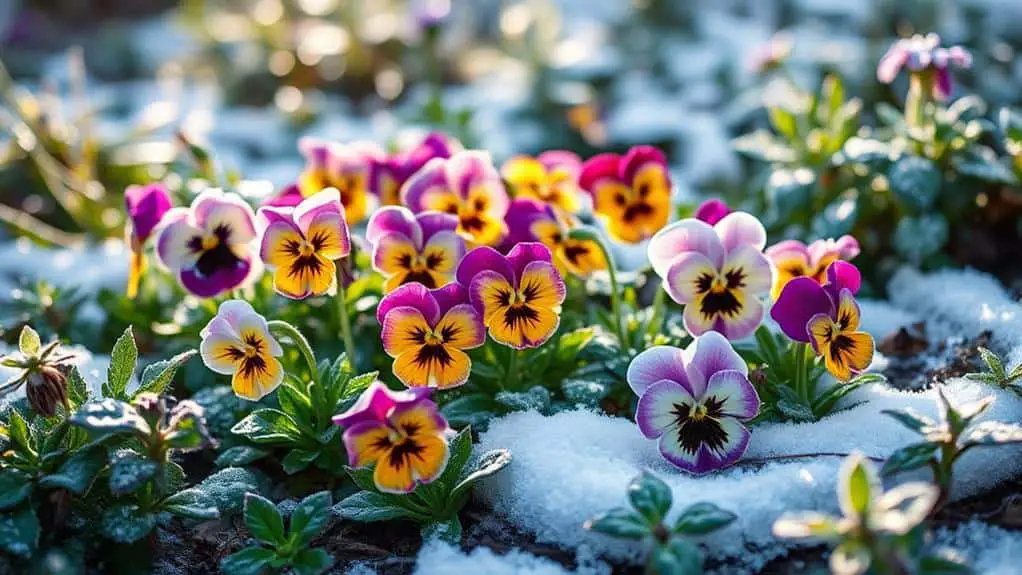
Despite the challenges winter poses, gardeners in USDA Zone 6 have shared remarkable overwintering success stories with pansies. With proper care, many have seen their pansies survive winter, often blooming into spring and summer.
Varieties like Maxim and Universal are particularly resilient. I've noticed that sheltered microclimates can make a big difference, offering much-needed protection against harsh conditions.
Overwintered pansies can sometimes get leggy, but regular maintenance and pruning help them stay healthy. One of the best parts? Pansies can self-seed, leading to new plants in the spring.
This means, with a bit of effort, you can enjoy continued blooms year after year. So, don't be discouraged—your pansies can thrive through winter!
Common Pansy Issues
Dealing with common pansy issues can be a challenge, but understanding the potential problems can make a big difference.
Here are some common issues you might encounter with your pansies:
- Pests: Aphids, slugs, and spider mites love pansies and can damage their leaves and flowers quickly. Keep an eye out and act promptly.
- Environmental Stress: Pansies need the right conditions. Too little sunlight, poor drainage, or extreme temperatures can stop them from blooming.
- Yellowing Leaves: This often signals overwatering, nutrient deficiencies, or disease. Adjust your care practices immediately.
- Winter Care: Proper winter care, like mulching and deadheading, can help your pansies survive and thrive in the spring.
Frequently Asked Questions
Do Pansies Come Back After Winter?
In my experience, pansies can come back after winter with proper pansy care. In warmer USDA zones 7 to 10, they often return, but in colder areas, they might not survive without extra protection like mulching.
Is There Such a Thing as Perennial Pansies?
Yes, there are perennial varieties of pansies. Some, like Maxim and Universal, have better cold tolerance. In USDA zones 7 to 10, they might survive winter and return in spring. Proper care increases their chances.
Can Pansies Survive the Summer?
I've noticed that pansies often struggle in hot summer months. For proper summer care, I move them to a shadier spot and water consistently. However, they might still go dormant and reemerge in cooler fall temperatures.
Will Pansies Survive Winter in Pots?
Yes, pansies can survive winter in pots with proper care. For winter care, place them in a sheltered spot, mulch well, and make certain they're watered before the ground freezes. This increases their chances of surviving harsh conditions.
Conclusion
So, are pansies perennials that will come back after winter? It depends on the type you plant and how well you prepare them for the cold. Hardy varieties like Maxim and Universal can make it through winters in zones 7 to 10. With proper care and a bit of luck, you'll see their cheerful blooms return. Don't forget to mulch and cut back! Happy gardening, and I hope your pansies flourish for many seasons to come.

